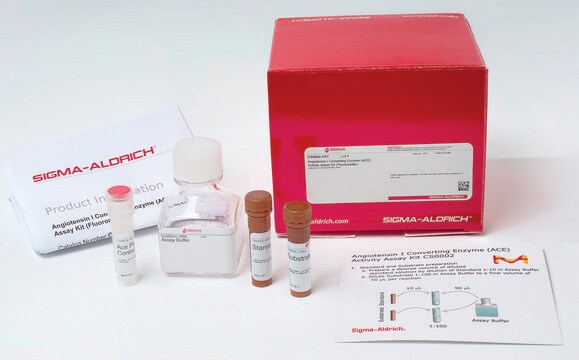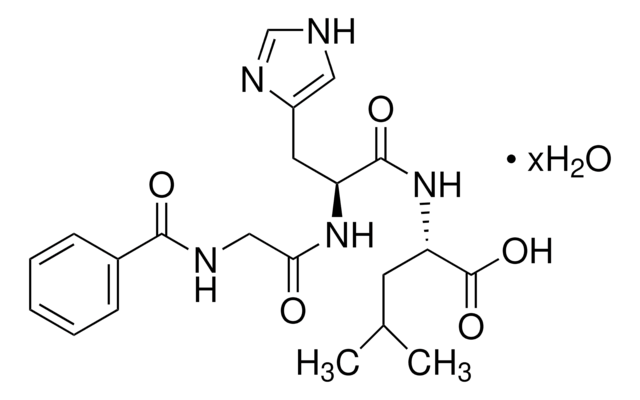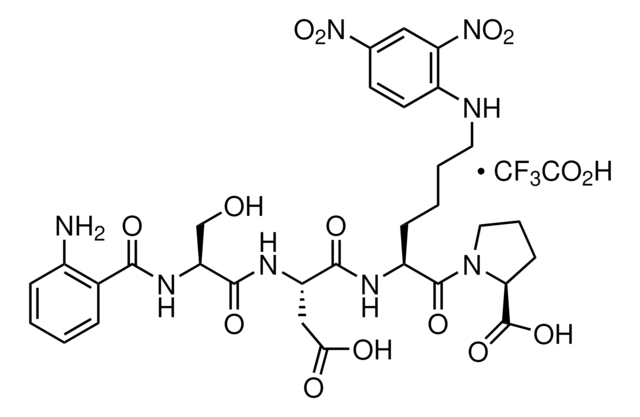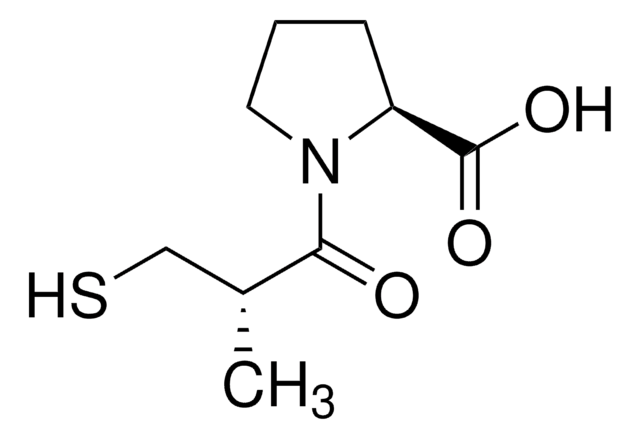A4980
Abz-FRK(Dnp)P-OH trifluoroacetate salt
≥95% (HPLC), film
Synonim(y):
o-Aminobenzoic acid-FRK(Dnp)P-OH, o-aminobenzoic acid-Phe-Arg-Lys(DNP)-Pro-OH trifluoroacetate salt, Abz-Phe-Arg-Lys(DNP)-Pro-OH
Zaloguj sięWyświetlanie cen organizacyjnych i kontraktowych
About This Item
Wzór empiryczny (zapis Hilla):
C39H49N11O10 · xC2HF3O2
Masa cząsteczkowa:
831.87 (free base basis)
Kod UNSPSC:
12352200
NACRES:
NA.77
Polecane produkty
Próba
≥95% (HPLC)
Formularz
film
kolor
yellow
temp. przechowywania
2-8°C
Powiązane kategorie
Amino Acid Sequence
Abz-Phe-Arg-Lys-DNP-Pro
Zastosowanie
Abz-FRK(Dnp)P-OH trifluorooctan (TFA) jest substratem dla enzymu konwertującego angiotensynę (ACE). Abz-FRK(Dnp)P-OH TFA został wykorzystany do badania zarówno zmniejszenia śmiertelności pacjentów z sepsą, jak i hipotermii wywołanej paracetamolem.
Działania biochem./fizjol.
Substrat dla ACE (enzym konwertujący angiotensynę). Wewnętrznie wygaszany substrat fluorogeniczny do testu fluorescencyjnego w czasie rzeczywistym.
Cechy i korzyści
Związek ten jest opisany na stronie Receptory angiotensyny w Podręczniku klasyfikacji receptorów i przekazywania sygnałów. Aby przejrzeć inne strony podręcznika, kliknij tutaj.
Ta strona może zawierać tekst przetłumaczony maszynowo.
Kod klasy składowania
11 - Combustible Solids
Klasa zagrożenia wodnego (WGK)
WGK 3
Temperatura zapłonu (°F)
Not applicable
Temperatura zapłonu (°C)
Not applicable
Wybierz jedną z najnowszych wersji:
Masz już ten produkt?
Dokumenty związane z niedawno zakupionymi produktami zostały zamieszczone w Bibliotece dokumentów.
Jérémie Neasta et al.
British journal of pharmacology, 173(8), 1314-1328 (2016-03-31)
Using an in-house bioinformatics programme, we identified and synthesized a novel nonapeptide, H-Pro-Pro-Thr-Thr-Thr-Lys-Phe-Ala-Ala-OH. Here, we have studied its biological activity, in vitro and in vivo, and have identified its target in the brain. The affinity of the peptide was characterized
Maria Fernanda de M Costa et al.
Journal of veterinary science, 12(1), 21-25 (2011-03-04)
Angiotensin-I converting enzyme (ACE) is a key regulator of blood pressure, electrolytes and fluid homeostasis through conversion of angiotensin I into angiotensin II. Recently, a genetic polymorphism of the ACE gene, which accounts for 47% of the variation of ACE
Arnau Hervera et al.
Molecular pain, 7, 25-25 (2011-04-14)
The local administration of μ-opioid receptor (MOR) agonists attenuates neuropathic pain but the precise mechanism implicated in this effect is not completely elucidated. We investigated if nitric oxide synthesized by neuronal (NOS1) or inducible (NOS2) nitric oxide synthases could modulate
Samir S Ayoub et al.
Drug metabolism and disposition: the biological fate of chemicals, 39(9), 1689-1695 (2011-06-02)
In recent years, there has been increasing interest in hypothermia induced by paracetamol for therapeutic purposes, which, in some instances, has been reported as a side effect. Understanding the mechanism by which paracetamol induces hypothermia is therefore an important question.
Wen Yang et al.
The Journal of pharmacology and experimental therapeutics, 339(3), 832-841 (2011-08-30)
Treatment with statins, inhibitors of HMG-CoA reductase, extends the survival of septic mice. However, the molecular mechanisms underlying the cholesterol-lowering, independent beneficial effects of statins in sepsis are poorly understood. The inhibition of protein isoprenylation, namely farnesylation and geranylgeranylation, has
Produkty
We offer many products related to angiotensin receptors for your research needs.
Nasz zespół naukowców ma doświadczenie we wszystkich obszarach badań, w tym w naukach przyrodniczych, materiałoznawstwie, syntezie chemicznej, chromatografii, analityce i wielu innych dziedzinach.
Skontaktuj się z zespołem ds. pomocy technicznej







![N-[3-(2-Furyl)acryloyl]-Phe-Gly-Gly](/deepweb/assets/sigmaaldrich/product/structures/225/349/530bc714-b1a8-4fdb-8082-a39329ee730a/640/530bc714-b1a8-4fdb-8082-a39329ee730a.png)
